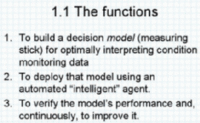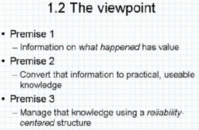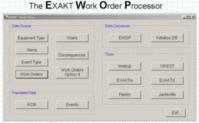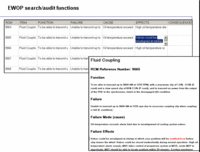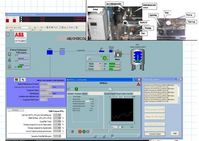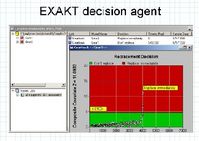omdec.com
http://www.omdec.com/moxie/Technical/Introducing.shtmlIntroducing EXAKT, EWOP, and Reliability-centered knowledge management
All software products fulfill a set of functions. But software requires that a user embrace the application's “culture” in order to use the program effectively.
All software products fulfill a set of functions. But software requires that a user embrace the application's “culture” in order to use the program effectively.
Slide 1
We would like to introduce the OMDEC approach to your Asset Optimization team.
Slide 2
Culture is, in essence, a set of definitions, symbols, and concepts aligned with a particular point of view. OMDEC’s software products subscribe to the culture of “reliability-centered maintenance”. The viewpoint stipulates that all maintenance decisions and actions derive from an enterprise’s policies. Some policies may be written as formal company guidelines and procedures. Others may be unwritten, flowing from habit and tradition. Either way, the effectiveness of the maintenance department depends on:
- the inherent wisdom of the policies,and
- the efficiency with which employees execute those policies.
A “model” is a method, or yardstick, for interpreting condition monitoring data. We build models to cover specific failure mechanisms. In the model building process we use EXAKT software to analyze past CBM inspection and event data. The software tells us whether a significant relationship exists between them. Then it guides us through the model building process. We test the model in the EXAKT modeling software. We then export the model for implementation by an agent – a watchdog that silently monitors new CBM data. Finally, we use the software to assess the performance of our CBM models. Using the EXAKT analytic tools, whenever necessary, we update the models as a result of new situations and experience.
Slide 4
The cultural viewpoint, that, historical recorded information has value, seems an obvious assertion. Yet, few companies exploit the data accumulated over many years, in order to formulate policies for taking optimal decisive maintenance actions.
If we accept Premises 1 and 2, we can proceed to manage knowledge effectively within an elemental representation, which is the RCM knowledge structure.
Slide 5
The EWOP software enables conversion of data and information advantageously to knowledge. We define “knowledge” in maintenance as the ability to decide upon and act upon changing information in an optimal manner. By “optimal” we mean that the actions we take support our objectives for the asset - for example: low cost, high availability, mission survival probabilty, or a desirable compromise amongst all three.
The EWOP user interface shown here assembles many important functions. Normally, however, these EWOP functions will be accessed through existing user interfaces, principally the CMMS.
The Work Orders button accesses the CMMS work order records. The RCM button displays the reliability-centered knowledge base.
The Events button displays the Events table – the vital link amongst the CMMS, the RCM knowledge base, and reliability analysis (RA) software[1].
In the bottom right segment of the user interface we find representative reliability analysis tools, With those applications we transform the systematic information in the Events table to optimal decision making knowledge.
Slide 6
On this slide we display some of the EWOP tools as they are used in an EWOP guided maintenance information process. At the top we view the “living” RCM knowledge base. Planners, technicians, and reliability engineers use these tools to instantly locate the appropriate reliability knowledge record, thereby solving the age-old "failure code problem". EWOP handles the update and quality control of the the growing and living reliability knowledge base, whose records apply to each significant maintenance and repair situation encountered.
A unique linkage between the CMMS and the RCM knowledge base empowers engineers to make effective use of reliability analysis software. EWOP event codes provide a precise yet convenient record of the occurance of each significant item-function failure-cause. RA software processes these “instances” in order to describe and evaluate failure behavior. The result maintenance policy improvement driving greater reliability and lower costs.
Finally, on the bottom left segment of the slide we access the RCM knowledge auditing, editing and quality control functionality. EWOP routes additions and changes (tracked in color and tagged with the author's name and date) to a RCM facilitator, reliabiltiy engineer, or planner who has been charged with reliability knowledge quality control. That person, discusses, accepts, reviews, and updates the RCM table.
Slide 7
At last we operate the RA tools – which, for course, is the sole purpose for having collected maintenance related data in the first place. Thanks to the EWOP generated Events tables, we may use these tools to assess information, extract knowledge, and build decision models.
The slide displays a hazard rate graph (one of many tools) at the top right, The Events table can be seen at the top left. And a “mapping” system is depicted the three tables in the lower half of the slide.
The mapping function allows us to associate more than one RCM knowledge record for combined analysis. Assume that we wish to analyze bearing failures across an entire class of ships. Then we can use EWOP to find and properly map those knowledge records to a “failure model” . Finally, we apply the range of RA tools at our disposal to study the resulting data sample.
Slide 8
The EWOP and EXAKT principles have been packaged by ABB, Oceana Sensor Technologies, and OMDEC in a physical demonstration hardware and software system, shown here.
The slide displays the user interface of the system. Superimposed on the top right hand corner, we can see the physical hardware. It includes a ABB variable frequency drive, a motor, a fault simulator with an unbalanced rotor, a vibration sensor, a digital signal processor, a failure mechanism, and software. The software platform is the ABB 800xA Asset Optimizer Workplace.
Random speed commands (recorded on the black background graph at bottom center) are sent to the drive. They induce realistic stress patterns on the failure mechanism (top right). Failure may occur at any time between 3 and 11 minutes. We do not know in advance when failure will occur. Nevertheless, at 30 second intervals, the EXAKT agent predicts remaining useful life. The prediction is based on vibration readings from the accelerometer and the working age of the component. The ABB Asset Optimizer WorkPlace graphical user interface displays both the residual life prediction and the optimal recommendation. Importantly, it displays, as well, updated KPIs (key performance indicators) that assess the value (to the asset’s user and owner) of the currently active CBM program and policy.
Slide 9
This slide shows a few of the CBM performance self-assessment techniques. OMDEC, Oceana Sensors, and ABB believe that every CBM program should monitor its own effectiveness. The right side depicts the hazard rate graph for potential failures and for functional failures. The closeness of the two curves testifies, in this case, that CBM is efficient. That is, it succeeds in pre-empting functional failures, yielding a FF hazard rate curve that is low and flat – the indicator of a well maintained component.
The bar chart on the bottom right is a histogram that evaluates the performance of EXAKT’s residual life estimation method. We see that, out of a total of about 675 estiamtes, 412 were within + or – 10%, while 20 were as much as 80% off. The point we are conveying is, that we must have a way to evaluate the predictiveness of our predictive maintenance program.
Slide 10
This slide shows the EXAKTd (EXAKT decision agent) user interface. From here we can display a table monitoring all components covered by the agent (in this case just two). The decision graph for Gear 2 is displayed. It is an unambiguous decision indicator. Normally the functions of the EXAKT decision agent are accessed directly by the CMMS and by other related maintenance systems.
Notes:
[1]Reliability-centered maintenance analysis (RCMA) is the study of failure modes that can reasonably occur in an asset. Reliability analysis (RA) is the study of failure modes that have occurred (including potential failures). Both these analytic processes populate a common knowledge base. They cross-fertilize with each other. RCMA forges the knowledge framework, while RA sanity checks the initial assumptions of RCMA. RCMA is a rigorous "facilitated" process for extracting knowledge from the most experienced engineers, operators, and technicians. RA (called "age exploration" by Nowlan and Heap) continually deepens the knowledge base.

